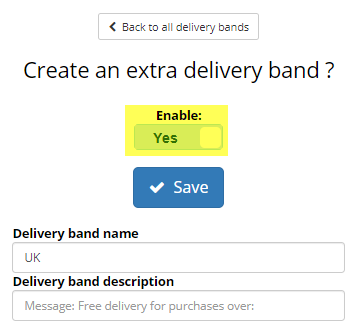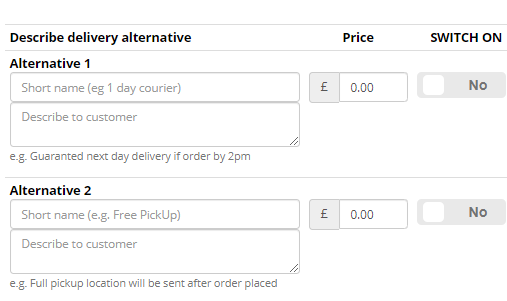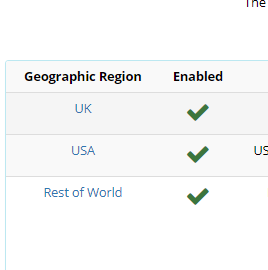1) Check Your Bands Are Enabled
This may seem like a bleeding obvious point to make, but it is an important one nonetheless. You may, for instance, have a UK delivery band and a USA delivery band. Imagine that you have briefly turned off the USA band and an order from New York comes through. There will be no delivery charge applied to this order, because the system checks the bands you have and fails to locate the one that applies. This leaves you, the business owner, with the trouble of fronting the entire delivery cost for an order from the USA. Nobody needs that.

2) Delivery Options Are Linked
Inside a delivery band, you have Option 1 (Free Delivery), Option 2 (Fixed Standard Price Postage) and Option 3 (Weight-Based Delivery). It is important to know that these options all work in conjunction with each other.
Let’s say you have a UK delivery band with all options activated. An order comes in. The system firstly checks to see if the order total is enough to activate your free delivery threshold. If it does, no delivery charge is applied. If it doesn’t, however, the system will apply Option 2 – the standard fixed delivery fee. Option 3, then, is only activated when Option 1 is not reached and Option 2 is disabled.
This structure is the same for every delivery band: Option 1 supersedes Option 2 and Option 2 supersedes Option 3.
3) Offer Alternative Delivery Methods
A relatively new DotGO feature, you can offer a more specific kind of alternative delivery method for customers who order your items. One obvious example would be to use the ‘Alternatives’ section to give customers who need an item as soon as possible the chance to pay a higher charge for a courier service that guarantees delivery by 2pm the next day.
And then you, the website owner, can choose whether this alternative delivery charge replaces the price stipulated by Options 1, 2 and 3, or whether the alternative delivery charge is added to this original fee. Having this option allows you to be even more specific when determining the exact delivery costs for every order that goes through your website.

4) Bands Are Ranked in Order of Priority
Delivery bands are always checked in the order that they were created and shown in the table. For instance, let’s say I have a delivery band for the UK, another one for the USA, and a final one for orders from the rest of the world. This means that every order that comes in will firstly be checked to see if the order’s country code matches with the UK delivery band, and if it does, the basket will stop matching and apply the UK delivery band rules accordingly.

If an order’s country code does not match the UK delivery band, it will then be checked to see if it matches the USA delivery band, and if the country code does not match that band either, the ‘Rest of the World’ one will be selected. This means that if I had created my ‘Rest of the World’ delivery band BEFORE I created the US one, the US band will never be matched because it comes AFTER the ‘Rest of the World’ delivery band, which matches with all countries outside the UK. So, always remember that the higher up the table, the higher the priority.
5) Weight Bands Are Determined by Your Items
When it comes to weight-based delivery, people can sometimes get a little confused. But there is an easy way to simplify the whole thing. If you apply delivery costs by weight, you will know the rough weight of every item in your website. That knowledge is important, because the weight bands below are essentially determined by the range of weights for your items.
For instance, the first weight band should incorporate the weight of most items in your website. If the majority weigh between 100g and 200g, you should set a band that goes between 0g and 250g, so that most items are accounted for by the price in this first band. You would then reserve the next band for your heavier items. You might go from 250g to 1000g in this weight band if your heaviest item is just under 1000g.

The final band, then, is essentially for orders of multiple items and should be determined by you – namely, how much do you need to charge to make orders exceeding 1000g (or whatever metric you choose for the higher end of weight band 2) cost effective? It ultimately comes down to the weight of your items and how those weights range from lightest to heaviest.
Do you own an E-commerce website but feel like you are not getting the most out of the tools at your disposal? Feeling a bit confused over some features? If so, don't worry - we've got you covered all the way.
DotGO doesn't just offer brilliant E-commerce website design tools; we also provide an extensive range of easy-to-follow, straight-to-the-point support videos that run you through everything you need to know. Whether you want to set up a professional email on your phone or add a downloadable product to your store, we have videos that run through the process, step by step.
Make sure you don't miss out on the amazing tools at your disposal. Take a look at our list of support videos and unleash the full potential of your online shop in no time.

